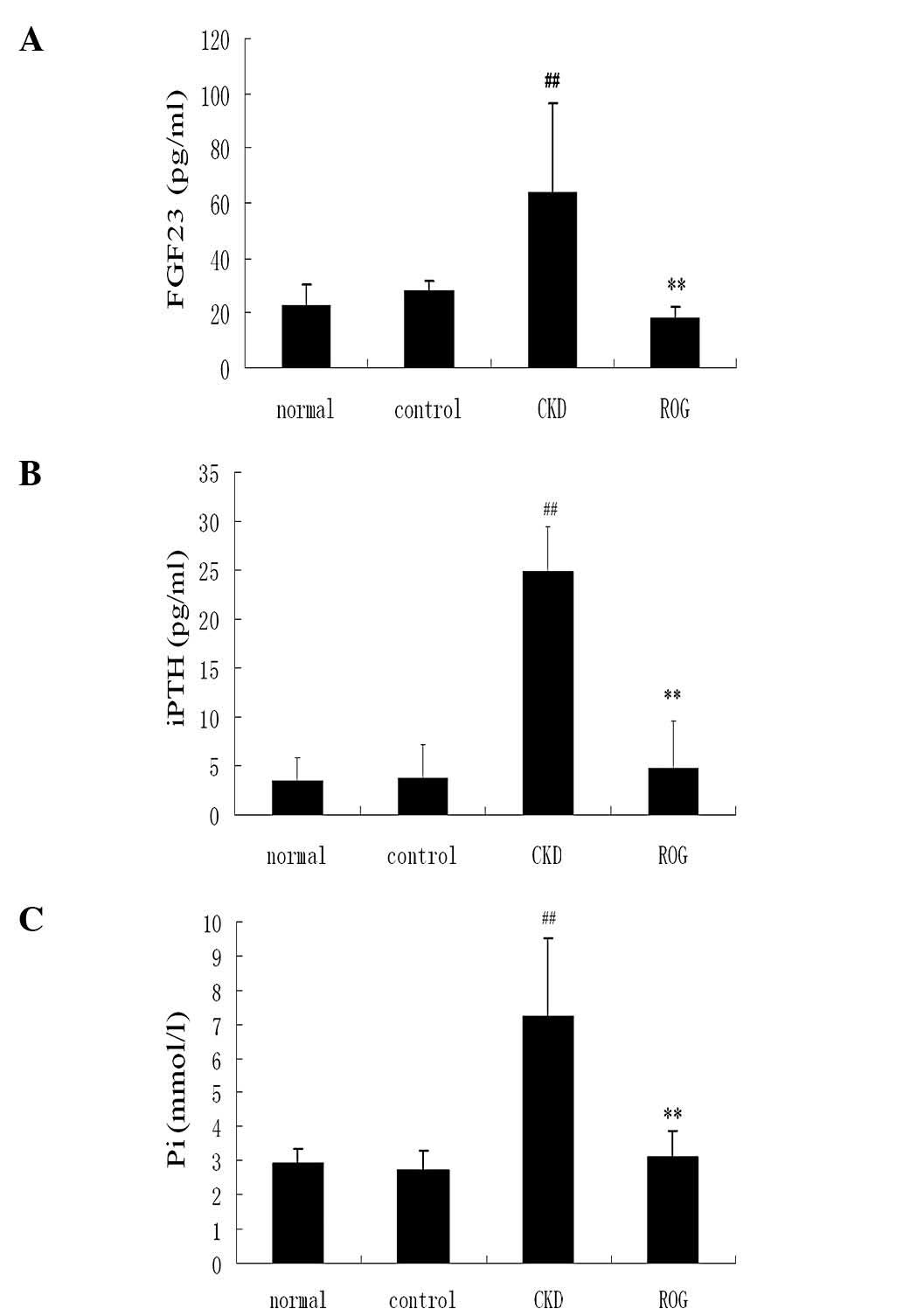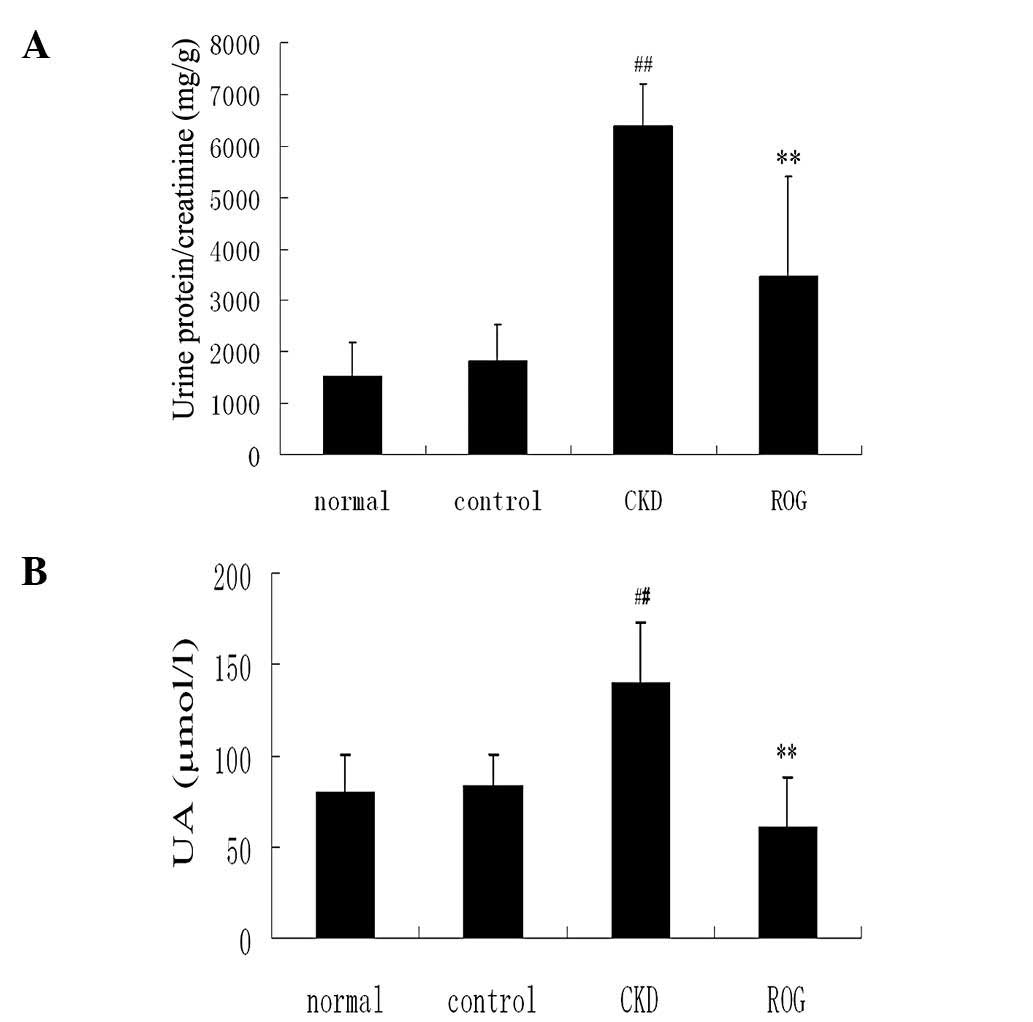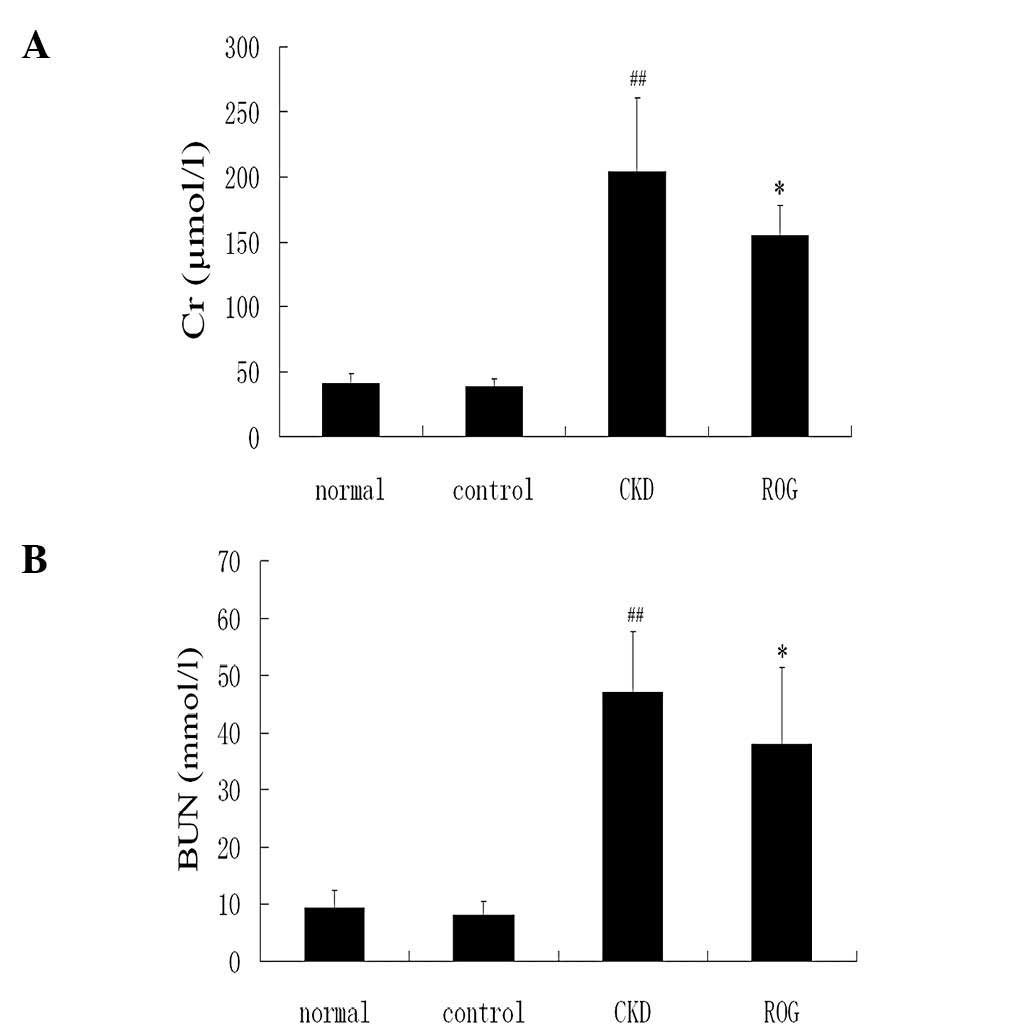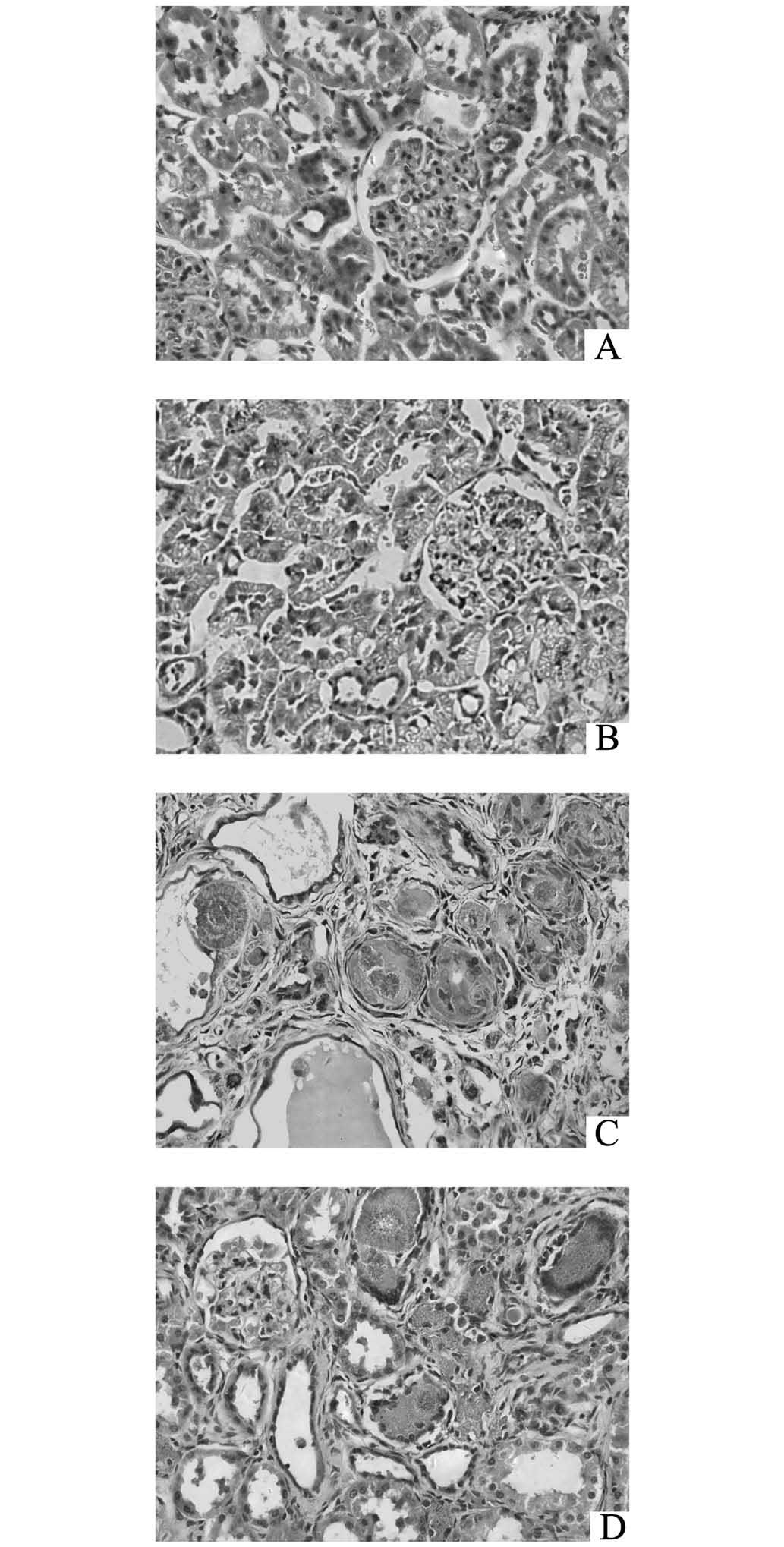Rosiglitazone alleviates injury in rats with adenine‑induced chronic kidney disease
- Authors:
- Published online on: October 8, 2013 https://doi.org/10.3892/mmr.2013.1715
- Pages: 1831-1835
Abstract
Introduction
Chronic kidney disease (CKD) is currently considered to be a predominant public health burden and a major cause of morbidity and mortality for diabetic and hypertensive patients worldwide. Recent clinical studies have revealed that persistent proteinuria and serum FGF-23 levels are powerful risk factors for the progression of end-stage renal disease (1–4).
Fibroblast growth factor-23 (FGF-23) is a newly identified member of the FGF family. FGF-23 is secreted from the bone and acts on the kidney to promote urinary inorganic phosphate (Pi) excretion and to suppress vitamin D synthesis, thereby maintaining Pi and calcium homeostasis (5,6). An increasing number of studies have confirmed that the circulatory levels of FGF-23, PTH and Pi are independent risk factors for CKD progression, and are closely correlated with vascular calcification and secondary hyperparathyroidism (7–9).
Proteinuria is a powerful and independent risk factor for kidney disease, cardiovascular disease and all-cause mortality (10). Thus, the reduction in proteinuria invariably translates into protection from a decline in renal function in order to improve the clinical outcome. All studies are committed to reduce proteinuria, improve renal function and extenuate complications in CKD patients (8–10).
Thiazolidinediones (TZDs) are ligands known to bind and activate the nuclear peroxisome proliferator-activated receptor-γ (PPAR-γ). TZDs are used to treat diabetes mellitus, and are known to exert their glucose-lowering effects by reducing insulin resistance through the stimulation of PPAR-γ nuclear receptor. In addition to improving glycemic control, TZDs have been demonstrated to exert beneficial effects on renal and vascular protection (11–15). In the present study, the effect of rosiglitazone (ROG) on proteinuria and renal function in CKD models induced by adenine was analyzed, and the contribution of the Pi-PTH-FGF-23 system was investigated.
Materials and methods
Animal study protocols
This study was conducted according to the guidelines of the National Institute of Health on the care and use of laboratory animals. The project was approved by the Institutional Animal Care and Use Committee of Sun Yat-Sen University. All rats were housed individually and were provided with normal laboratory chow and tap water ad libitum throughout the study. The animals were handled daily to minimize handling stress. Male SD rats (weight, 250–280 g) were obtained from the Animal Center of Sun Yat-Sen University (Guangzhou, China). The SD rats were divided randomly into four groups (n=6 per group): i) Normal group, intragastric administration of saline consistently for four weeks; ii) ROG controls, intragastric administration of rosiglitazone (GlaxoSmithKline plc., Tianjin, China) 10 mg/kg/day consistently for four weeks; iii) CKD model group, intragastric administration of 200 mg/kg/day adenine (Sigma-Aldrich, St. Louis, MO, USA) consistently for four weeks; and iv) ROG treatment group, intragastric administration of ROG (10 mg/kg/day) and adenine (200 mg/kg/day) consistently for four weeks. All rats were sacrificed, and the kidney tissues and blood samples were collected at the end of four weeks. Urine samples of 24-h were collected on the day prior to the rats being sacrificed.
Biochemistry assay
The blood and urine samples from the rats were centrifuged at 1,120 × g for 10 min. The levels of serum creatine (Cr), blood urea nitrogen (BUN), uric acid (UA), calcium, phosphorus, intact parathyroid hormone (iPTH), alkaline phosphatase (ALP) and the 24-h protein/Cr ratio of the urine were tested by an autoanalyzer (Abbott, Chicago, IL, USA) in duplicate.
Enzyme-linked immunosorbent assay (ELISA)
The serum levels of FGF-23 were measured by ELISA (FGF-23 ELISA kit; Immutopics, San Clemente, CA, USA) according the manufacturer’s instructions.
Hematoxylin and eosin (HE) staining and pathological analysis
The kidneys were fixed in 4% paraformaldehyde overnight and embedded with paraffin for HE staining. Semi-quantitative histological scoring was performed by a pathologist. The scoring of the tubular interstitial damage index (TIDI) used the following criteria: The tubular atrophy and interstitial infiltrates were scored as absent, 0; involving <25% of the biopsy area, 1; involving 26 to 50% of the biopsy area, 2; and involving >50% of the biopsy area, 3. The presence of proteinaceous casts was scored as absent, 0; isolated, 1; present in ≤10% of tubules, 2; and present in >10% of tubules, 3. Tubular dilation was scored as absent, 0; mild, 1; moderate, 2, when associated with flattening of the tubular epithelium; or severe, 3. Tubular dilation was scored as severe, 3, when the diameter exceeded that of the glomeruli; these tubules were often filled with proteinaceous casts.
Statistical analysis
The statistical analysis was conducted using analysis of variance (SPSS 13.0 software: SPSS, Inc., Chicago, IL, USA). P<0.05 was used to indicate a statistically significant difference. The results are expressed as the mean ± SE.
Results
Effect of ROG on the Pi-PTH-FGF-23 system
The serum levels of FGF-23 were significantly higher in the CKD model group compared with those of the normal group (64.3±13.2 versus 23.2±7.2 pg/ml; P<0.01). The value of FGF-23 was significantly decreased in the ROG treatment group compared with the CKD model group (17.9±4.5 versus 64.3±13.2 pg/ml; P<0.01). The serum levels of iPTH and Pi were also significantly higher in the CKD model compared with the normal group (P<0.01), but significantly reduced following treatment with ROG in comparison with the CKD model (P<0.01; Fig. 1A–C). However, there were no significant differences in serum calcium and ALP levels among the four groups.
Effect of ROG on proteinuria and renal function
The ratio of protein/Cr of the urine was significantly increased in the CKD models compared with that in the normal group (6,391.4±1,923.0 versus 1,526.1±719.5 mg/g; P<0.01). However, ROG significantly reduced the proteinuria content compared with the CKD models (3,469.75±887.55 versus 6,391.41±1,923.02 mg/g; P<0.01)(Fig. 2A–C). Serum Cr, BUN and UA levels were also significantly increased in the CKD models group compared with the normal group. It is noteworthy that the levels of renal function were significantly improved following treatment with ROG (Fig. 3A–C).
Renal pathological variation
HE staining demonstrated that the proximal convoluted tubules were swollen, while the distal convoluted tubules and the collecting ducts were expanded with considerable protein casts and 2,8-dihydroxyadenine crystals in the lumina (Fig. 4C). Monocytes proliferated around the crystals and created nodules, and inflammatory cells infiltrated into the interstitial tissue (Fig. 4C). However, ROG markedly improved the aforementioned pathological lesions, as shown in Fig. 4D. The TIDI values of the CKD models were significantly increased compared with those of the controls (P<0.01), while ROG also significantly improved the TIDI (P<0.05, Table I).
Discussion
In the present study, the CKD rat models were successfully induced with an intragastric administration of adenine, and the serum levels of FGF23, PTH and Pi were confirmed to be consistent with the levels in the lesions of the kidney in this model. Furthermore, this is the first study to demonstrate that ROG was able to attenuate renal damage and metabolic disorders in adenine-induced CKD models. ROG, a PPAR-γ agonist, has been indicated to exert cardiovascular and renal protection through the improvement of anti-inflammation, antiproliferation and antioxidative stress (13–18). These data demonstrated that ROG exerts a polyphenic profit on the cardiovascular and renal system. However, the effect of PPAR-γ on renal proteinuria and renal function are not yet fully understood.
The present study confirmed the effect of ROG on FGF-23 levels and proteinuria, each a risk factor of CKD, thus providing a novel insight into the renoprotective properties of the drug. The results of this study demonstrated that the serum FGF-23, PTH and Pi levels were markedly increased in adenine-induced CKD rats, but that ROG was able to effectively attenuate the augmentation. FGF-23 is part of a previously unrecognized hormonal bone-PTH-kidney axis. Mineral and bone metabolism may be viewed as a complex system in which three hormones (PTH, calcitriol and FGF-23) act on three key organs (the kidneys, intestines and bones) to adjust plasma, calcium and phosphorus concentrations (19). Mineral disorders, including an increase in FGF-23 and PTH, and hyperphosphatemia, are independent risk factors in CKD progression and mortality (3,20,21). The present data revealed that ROG reduced the serum levels of FGF-23, PTH and phosphorus in the CKD rats, indicating that ROG may have a beneficial effect on the kidney through the attenuation of mineral disorders in adenine-induced CKD models.
It was also observed that the intervention with ROG decreased the proteinuria and protected the renal function in the adenine-induced CKD models. The present results were consistent with other experimental studies that demonstrated that TZDs are beneficial for renal and cardiovascular protection (13,18,22,23). ROG intervention attenuated hyperuricemia, which is generally acknowledged as an independent risk factor of CKD. Thus, the current study revealed that ROG, a PPAR-γ agonist may decrease proteinuria and attenuate metabolic disorders, including mineral disorders and hyperuricemia, in adenine-induced CKD models. Therefore, a novel renoprotective effect of TZDs may be indicated based on the present study. Further studies are required to confirm these findings.
Acknowledgements
The authors would like to thank Professor Wenfang Chen from the Department of Pathology, The First Affiliated Hospital, Sun Yat-Sen University. This study was financially supported by the Natural Science Foundation of Guangdong Province, China (grant no. 2012B031800448) and the Foundation of The Educational Ministry (grant no. 2013BSD).
References
|
Bello AK, Hemmelgarn B, Lloyd A, James MT, Manns BJ, Klarenbach S, et al: Associations among estimated glomerular filtration rate, proteinuria, and adverse cardiovascular outcomes. Clin J Am Soc Nephrol. 6:1418–1426. 2011. View Article : Google Scholar : PubMed/NCBI | |
|
Sarnak MJ and Astor BC: Implications of proteinuria: CKD progression and cardiovascular outcomes. Adv Chronic Kidney Dis. 18:258–266. 2011. View Article : Google Scholar : PubMed/NCBI | |
|
Faul C: Fibroblast growth factor 23 and the heart. Curr Opin Nephrol Hypertens. 21:369–375. 2012. View Article : Google Scholar : PubMed/NCBI | |
|
Nakano C, Hamano T, Fujii N, Obi Y, Matsui I, Tomida K, et al: Intact fibroblast growth factor 23 levels predict incident cardiovascular event before but not after the start of dialysis. Bone. 50:1266–1274. 2012. View Article : Google Scholar : PubMed/NCBI | |
|
Razzaque MS and Lanske B: The emerging role of the fibroblast growth factor-23-klotho axis in renal regulation of phosphate homeostasis. J Endocrinol. 194:1–10. 2007. View Article : Google Scholar : PubMed/NCBI | |
|
Shimada T, Kakitani M, Yamazaki Y, Hasegawa H, Takeuchi Y, Fujita T, et al: Targeted ablation of Fgf23 demonstrates an essential physiological role of FGF23 in phosphate and vitamin D metabolism. J Clin Invest. 113:561–568. 2004. View Article : Google Scholar : PubMed/NCBI | |
|
Seiler S, Heine GH and Fliser D: Clinical relevance of FGF-23 in chronic kidney disease. Kidney Int Suppl. 76:S34–S42. 2009. View Article : Google Scholar : PubMed/NCBI | |
|
El-Abbadi MM, Pai AS, Leaf EM, Yang HY, Bartley BA, Quan KK, et al: Phosphate feeding induces arterial medial calcification in uremic mice: role of serum phosphorus, fibroblast growth factor-23, and osteopontin. Kidney Int. 75:1297–1307. 2009. View Article : Google Scholar : PubMed/NCBI | |
|
Gutiérrez OM, Mannstadt M, Isakova T, Rauh-Hain JA, Tamez H, Shah A, et al: Fibroblast growth factor 23 and mortality among patients undergoing hemodialysis. N Engl J Med. 359:584–592. 2008.PubMed/NCBI | |
|
Sharma SK, Zou H, Togtokh A, Ene-Iordache B, Carminati S, Remuzzi A, et al: Burden of CKD, proteinuria, and cardiovascular risk among Chinese, Mongolian, and Nepalese participants in the International Society of Nephrology screening programs. Am J Kidney Dis. 56:915–927. 2010. View Article : Google Scholar : PubMed/NCBI | |
|
Reel B, Guzeloglu M, Bagriyanik A, Atmaca S, Aykut K, Albayrak G and Hazan E: The effects of PPAR-γ agonist pioglitazone on renal ischemia/reperfusion injury in rats. J Surg Res. 182:176–184. 2013. | |
|
Basturk T, Unsal A, Ulas T, Koc Y, Sakaci T, Ahbap E and Borlu F: Effects of rosiglitazone treatment on insulin resistance and TNF-alpha levels in patients with chronic kidney disease: a prospective study. Eur Rev Med Pharmacol Sci. 16:1519–1524. 2012.PubMed/NCBI | |
|
Setti G, Hayward A, Dessapt C, Barone F, Buckingham R, White K, et al: Peroxisome proliferator-activated receptor-γ agonist rosiglitazone prevents albuminuria but not glomerulosclerosis in experimental diabetes. Am J Nephrol. 32:393–402. 2010. | |
|
Ren L, Liu N, Zhi H, Li Y, Li Y, Tang R, et al: Vasculoprotective effects of rosiglitazone through modulating renin-angiotensin system in vivo and vitro. Cardiovasc Diabetol. 10:102011. View Article : Google Scholar : PubMed/NCBI | |
|
Alessi A, França Neto OR, Prim C, Silva RF, Noronha Ld, Brofman PR, et al: Rosiglitazone and vascular injury in hypercholesterolemic rabbits: neointimal formation assessment. Arq Bras Cardiol. 95:283–288. 2010.PubMed/NCBI | |
|
Nakaya H: Roles of PPARgamma in preventing the development of atherosclerosis in LDL receptor null mice. Nihon Rinsho. 68:229–234. 2010.(In Japanese). | |
|
Schiffrin EL: Peroxisome proliferator-activated receptors and cardiovascular remodeling. Am J Physiol Heart Circ Physiol. 288:H1037–H1043. 2005. View Article : Google Scholar : PubMed/NCBI | |
|
Hu W, Yu Q, Zhang J and Liu D: Rosiglitazone ameliorates diabetic nephropathy by reducing the expression of Chemerin and ChemR23 in the kidney of streptozotocin-induced diabetic rats. Inflammation. 35:1287–1293. 2012. View Article : Google Scholar : PubMed/NCBI | |
|
Bergwitz C and Jüppner H: Regulation of phosphate homeostasis by PTH, vitamin D, and FGF23. Annu Rev Med. 61:91–104. 2010. View Article : Google Scholar : PubMed/NCBI | |
|
Pontoriero G, Cozzolino M, Locatelli F and Brancaccio D: CKD patients: the dilemma of serum PTH levels. Nephron Clin Pract. 116:c263–c268. 2010. View Article : Google Scholar : PubMed/NCBI | |
|
Levin A, Djurdjev O, Beaulieu M and Er L: Variability and risk factors for kidney disease progression and death following attainment of stage 4 CKD in a referred cohort. Am J Kidney Dis. 52:661–671. 2008. View Article : Google Scholar : PubMed/NCBI | |
|
Kincaid-Smith P, Fairley KF, Farish S, Best JD and Proietto J: Reduction of proteinuria by rosiglitazone in non-diabetic renal disease. Nephrology (Carlton). 13:58–62. 2008. View Article : Google Scholar : PubMed/NCBI | |
|
Betz B, Schneider R, Kress T, Schick MA, Wanner C and Sauvant C: Rosiglitazone affects nitric oxide synthases and improves renal outcome in a rat model of severe ischemia/reperfusion injury. PPAR Res. 2012:2193192012. View Article : Google Scholar : PubMed/NCBI |













